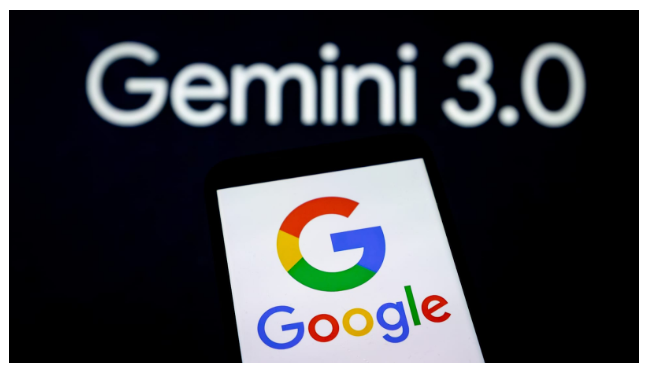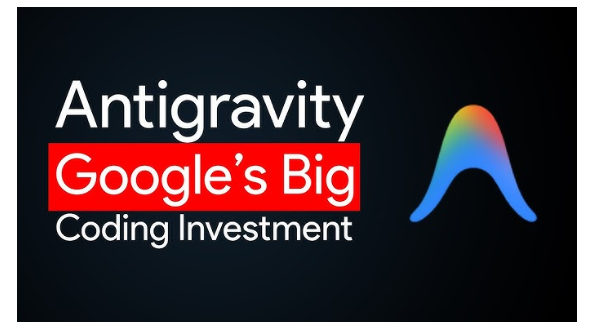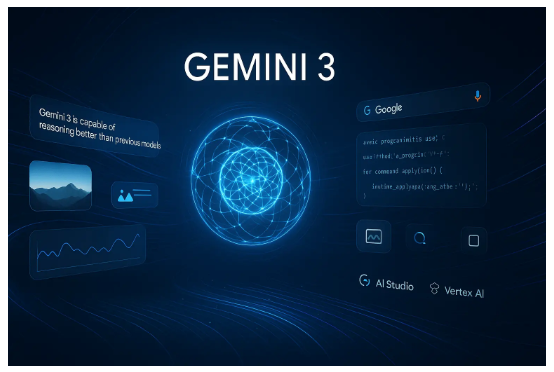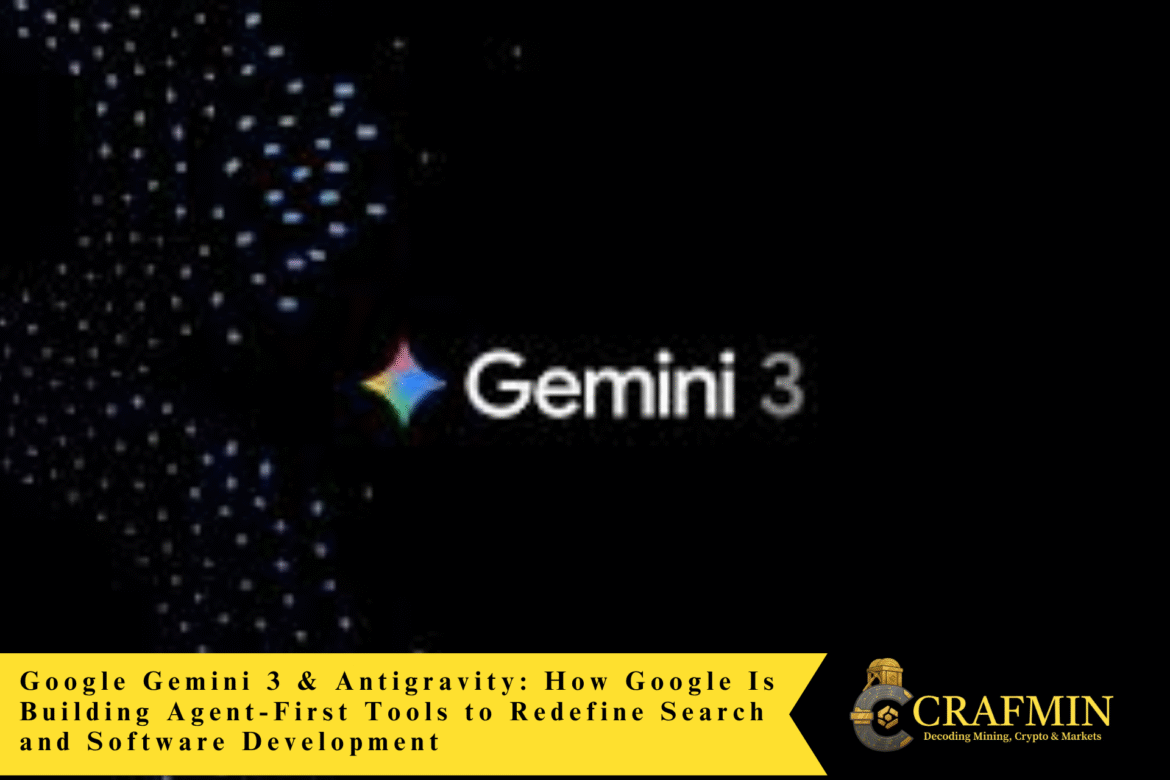Google has only recently released Gemini 3, Antigravity, which not only reflects their dual release policy, indicating Google’s shift in its environments from “search plus” to “agent first,” in which “software tools and search work together like teammates.” Gemini 3 is “agent first” reason and multimodal transformation, which Google has integrated from inception into their Search, Google’s developer toolkit. Antigravity is Google’s new agentic developer environment, which is built on Gemini 3 Pro, “enabling multiple partially autonomous agents to work together in a code editor, terminal, and web browser, while being understandable and auditable in what they do.” (blog.google)

Gemini 3 and Antigravity enable transparent, agent-first collaboration. (Image Source: CNBC)
Why It’s Relevant Now
It’s not an evolution in its functionality. It transforms the entire paradigm in which answers to these questions would be searched for, in which applications would be developed, and in which productivity would be measured in these companies. Google’s vision for ‘search’ extends far beyond its goal to provide ‘a list of links.’ It’s providing answers to these queries in ways which are ‘interactive’, ‘targeted at ‘tasks’, with ‘agents’: small goal-oriented computer systems which have ‘the capacity to operate ‘tools’ with ‘context’.
Dynamics Changed By Gemini 2
Gemini 3 enhances critical thinking for text, image, audio, or video, with “deep think” functionality for difficult problems, in Google’s Gemini app or in conjunction with Google Search’s “AI Mode,” which itself enables more interactive experiences such as simulations, designs, or guides, not just text answers. More specifically, for its multimodal functionality, there is its utilization not only in conversational answers, such as in Google’s Google Assisted Conversations, but also in extending Google Search results to be usable tools.
What Antigravity Truly Is
Antigravity is described as “a development environment in which agents are first-class citizens.” It means, in essence, “you’ll have an Editor view, which looks like what you’d expect from an IDE, with side-panel agents, and you’ll have a Manager view, which is like mission control, where you orchestrate many agents in many workspaces.” Agents have “access to the editor, terminal, and browser, while they produce ‘Artifacts’ such as task lists, plans, screenshots, or browser recordings, to document what they did.” It seeks to alleviate “the black box problem, in which software tooling performs actions on behalf of some person.”

Antigravity lets agents work across tools while creating Artifacts to show exactly what they did. (Image Source: YouTube)
What The Agent-First Model Means For Developers
Picture a junior developer with enough autonomy to code, perform unit tests, create a pull request, and attach an Artifact to guide someone on their testing process. Antigravity integrates different agents, such that one could code, while another could scan for security, with yet another carrying out integration tests on code. Here, while you physically participate in Artifacts, coding is no longer repetitive.
A New Type Of Trust, Based On Transparency
Antigravity’s Artifacts: It’s an interesting concept. Artifacts aren’t simply logs, as they have information in a readable, understandable fashion for human eyes, explaining why an agent made a particular decision, with references to support their decision. It’s crucial for adoption, given the importance for developers to understand why something changed, and what evidence validated their decision. It’s all about taking responsibility for automated tasks, looking for regions in automated tasks for which more validation is needed. It’s moving towards collaboration, not towards replacing humans.
What It Means For Search, For Those Who Aren’t Programmers
Transitioning from being a destination for seeking to being a destination for acting. Gemini 3’s filling in an answer in AI Mode could include interactive elements: graphics to be edited, simulations to be modeled, or mini-applications to walk you through an action plan. For the layperson, it could simply be enhanced, faster, improved problem-solving, such as home renovations with an action plan, budget, vendors, and timeline, in an interactive process complete with a timeline made with and improved by Google’s Search. It’s not about finding, it’s about acting, too, for businesses.
The Commercial Logic: Why Google Pushes This Now
Google incorporates its models into income-generating products such as Search, Workspace, and cloud services. Functions in new models are rolled out into products with a reach in the tens of billions, with no need for any installs. It’s almost like Google model improvements translate to Google product improvements on the internet. It’s not difficult to interpret what Google’s message is in all these, though: If they improve Search, their overall income streams are secured in their capacity to retain people’s attention.
Consequential Outcomes: Effects On Jobs/Developer Positions
It’s not only a concern, there’s complexity too in these matters. Antigravity applications, having applications of an antigravity type, have junior dev superpowers, possessing ‘scut work in scut work’s time.’ These applications fuel job dislocation concerns. But job dislocation isn’t what’s being suggested, with job transformation being what’s meant: senior dev jobs transform into architects, auditors, for agent behavior, regarding overall system designs, risk management, and powerful code. What’s most likely to happen to companies, in light of these applications, is new job types for their management.
Software engineers are the translation layer between the market and the computer. In a world where AI agents will generate 10X or 100X more code than humans, this translation layer will be more important than ever.
With AI agents dramatically lowering the raw cost of code… https://t.co/DSwPUTO0Os
— Aaron Levie (@levie) October 13, 2025
Security, Governance, and Regulation
Accountability and security are central considerations in modern agentized systems. In general, if these agents are allowed to run from browsers, terminals, or editors, governance is no longer negotiable. Antigravity’s goal to maintain artifacts with the possibility for human comments is an accommodation, while enterprise customers will demand more substantial mechanisms for managing access, logging, and regulatory compliance. Expect increased vendor activity in hardened, auditable agent deployment in regulated environments. Google’s public preview support for multiple platforms, including support for third-party models, provides a playground for governance frameworks.
A Crypto Lens: Why Blockchain and Web3 People Should Care
For those in crypto, agentized systems intersect with several critical priorities. First, reproducibility allows artifacts to deliver verifiable trails for on-chain activity or off-chain processes leading to contracts. Second, economic agents with test functionality, simulations for economic systems, or audited report generation will accelerate protocol development. Third, constructing trustless primitives can benefit from agentized infrastructure, such as producing audited, signed traces for inclusion in governance proposals or developer dashboards. Agents facilitate faster development for dev teams, providing better trails for decision-making in crypto projects.

Agentized systems in crypto ensure reproducibility and auditable trails. (Image Source: MDPI)
Real-Life Applications
Take, for example, the process of shipping a minimum viable product (MVP) for a new start-up. Antigravity’s process could enable infrastructural support for the backend, execute tests for launch, formulate a launch plan, and draft marketing copy, while the founder focuses on acquiring customers. In these areasanalysis, complexity, and ethicsAntigravity’s founders possess a crucial competitive advantage. Google’s pitch also relies heavily on these capabilities.
I like how in Google AntiGravity , that it has a cohesive view of the artefacts:
– Implementation Plan
– Task Todos
– WalkthroughPrefect for the before, during and after phases of development.
Well played Google. pic.twitter.com/czDLrdnUPc
— Chong-U (@chongdashu) November 18, 2025
Early Response to Disasters, Media, and Narrative
Reader interaction ranges from enthusiastic to wary. Tech journals highlight new developments such as Gemini 3’s multimodal inference and Antigravity’s agent orchestration. Analysts focus on disruptions to employment and the new governance paradigms required. Google responds to critics with designs for transparency and collaboration, though their practical impact on real-world problems remains a topic of debate.
Deep Tech Capabilities
Gemini 3
Gemini 3 completes the loop for reasoning, tooling, and multimodal responses. It targets excellence in three areas: solving complex problems stepwise, engaging with terminal and tooling contexts for coding, and improving comprehension in multimodal scenarios, enabling it to combine text, images, or short video responses seamlessly. Google compares Gemini 3’s performance to other developer suites, noting significant improvements in terminal-based tool interaction essential factor for agent interactions with shells, editors, or browsers.
Antigravity
Antigravity introduces an orchestration layer atop model functionalities. It treats agents as modular workers, each assigned an objective, a toolbox with specific functionality (editor, terminal, browser), and rules for authorization. Their outputs, called artifacts, are readable, structured data that describe what an agent did and why, including lists, screenshots, browser captures, and test outcomes. This approach deliberately aligns autonomy with explainability and auditability, allowing automated workflows to run with full documentation.
Antigravity supports multiple agent interactions and model versatility, including integration with Google’s Gemini 3 Pro model out of the box. It is also interoperable with other models like Anthropic’s Sonnet 4.5 or GPT-OSS, depending on constraints such as cost, latency, or other limitations, without requiring new model designs.

Gemini 3 powers reasoning and multimodal tasks; Antigravity manages agents with auditable outputs. (Image Source: supergok.com)
Practical Adoption Strategies for Individual Developers
- Start with an Atomic Mission: Pick a repeatable development task, such as scaffolding an endpoint with tests. Automate an agent flow with two agents: one scaffolds code, the other tests and produces artifacts. Run on your computer, analyze the artifact, and optimize agent interactions and privileges to improve code output.
- Record Each Running Process: Antigravity’s artifacts are highly valued in testing. Treat artifacts as primary test results, storing them with each pull request and referencing them in code reviews. This approach allows reviewers to see the exact test environment each agent operated in, reducing discussion time.
- Set and Tune Agent Privileges: Assign restricted privileges to agents for each action, then expand as needed while determining the agent’s role. For tasks involving sensitive information, use ephemeral credentials that reset after each session.
- Pair Programming With Agents: Pair an agent with a human reviewer across several sprints. Agents lack domain knowledge, which humans must provide to develop effective heuristics. Over time, agents will contribute fewer low-value actions, increasing overall efficiency.
Team Level Adoption: Workflows, Governance
- Run pilots on non-critical projects. Pick features in greenfield projects, development productivity, or developer projects where any mistakes won’t affect customers. If Artifacts are submitted in PRs, these KPIs will be tracked: Time Saved Per Task, Quality Regression (Bugs Added), and Average Review Time.
- Maintain an Agent Registry. Document each agent’s purpose, model, permissions, and owner. This functions as an in-house catalog: representatives from security, compliance, and engineering must understand what’s running on which hosts, and whom to contact for changes.
- Enforce stringent approval gates. Manual approval gating must be enforced on any merge to production involving code with agents. Use Artifacts for faster approval gating: reviewers can view test results, browser recordings, and explanation rationale before approving merges.
- Keep provenance in records. Tracking Artifacts with commit information, along with an English summary before merge, is highly useful for audits and post-mortems.
Enterprise Security and Governance Checklist
- Principle of Least Privilege
Agents shall have no more privileges than necessary for their operation. Ephemeral credentials shall be provided for connectivity with cloud services and databases. - Artifact Retention Policy
Define what Artifacts to retain and for how long. Artifacts are useful for audits but contain sensitive output. Encryption is required to control access. - Access Control and RBAC
Integrate Antigravity with your Identity Provider. Access to create or modify agents, manage permissions, or deploy agent workflows is restricted to designated personnel. - Test and Validate Agent Output
Automation testing suites must be utilized on any code that has been generated. High-risk code changes require code reviews. - Logging and Monitoring
Send agent activity logs to your SIEM platform. Monitor for anomalies such as unusual outgoing network activity or new resource accesses. - Rules for Data Handling
Agents must not process PII or consumer secrets unless necessary. Sanitize inputs whenever possible. - Legal and Compliance Check
If collecting regulated data (health, financial, etc.), establish early legal sign-off on risk controls. - Incident Response Playbook
Include steps for withdrawing agent credentials, reverting agent commits, or isolating systems if an agent begins acting abnormally.
These guardrails enable organisations to adopt agents from experimental stages to production safely.
Comparative Analysis: An Overview of Market Players
Some companies have already rolled out agent-like functionality in their IDE interfaces or cloud management consoles. Antigravity emphasizes multimodal integration support, Artifacts for explanation, and overall integration with Google Search, Google Cloud, and its ecosystem. Other projects often emphasise individual assistant-based completion or copilot functionality. In contrast, Antigravity functions as an agent coordinator, with multiple meaningful workers acting in concert across multiple environments. Its platform ecosystem philosophy, enabling Sonnet 4.5 and GPT-OSS, provides better compatibility than point solutions such as language server plugins.
Competitors may emphasize specialization: some offer secure enterprise environments, while others provide low-cost open-source platforms. Companies must assess the value of Google’s deep Search and Workspace integration for their use cases.
Prepared for Press Interviews: Sound Bites
- “Agents are visible, not mysterious, with Antigravity. Artifacts provide teammates with trusted results from automated analysis, ensuring every action is documented.”
- “This isn’t about replacing engineers – it’s about shifting their time from plumbing to problem-solving.”
- “Start small: automate low-risk repeatable work, and measure. Agents will only scale if governance scales with them.”
- “The advantage is reproducibility. If an agent made some change, you could literally see why and how.”
- “Model choice matters – flexibility to switch models gives teams control over cost and compliance.”
Also Read: How Baidu’s ERNIE 5.0 Sets a New Standard: Exploring the Rise of Omni-Modal AI Models
Quick Checklist for Shipping a First Agent Project (Hands-On Steps)
- Find a small-scope task (e.g., code with scaffolded example code, example test).
- Add functionality for creating and testing agents.
- Run locally; collect Artifacts.
- Evaluate Artifacts; iterate on prompts and permissions.
- Add validation for CI and require sign-off.
- Start publishing the agent to the internal registry and assign an owner.
- Data collection: monitor for 2–4 sprints.
From Developer Trials to Enterprise Adoption
Google has launched Gemini 3 and Antigravity, signifying their ambitious plan to move toward agent-first development. Gemini 3 improves reasoning, multimodal understanding, and tool interaction, while Antigravity facilitates agent coordination to collaborate in an IDE-like setting. Agents produce Artifacts, i.e., readable files (screens, test result logs, plans), for action validation and responsibility. Developers: small-scale pilots on auto-repetitive tasks reveal major productivity improvements. Enterprises: manage governance by enforcing least privilege, Artifacts, and approvals for production changes. Antigravity’s support for multiple models, integrated with Search, benefits Google’s distribution channel, while companies need to manage ambitions carefully. Start small, analyse, then collaborate with agents with appropriate management.
Concluding Remarks: Big Picture
Gemini 3 and Antigravity are not a simple switch but a nudge to an entire ecosystem. Improvements in scaffolding, audit trails, and handoff are evident. Risks are manageable if agents are assigned tasks as any new employee would be, producing output with normal quality expectations.
Frequently Asked Questions
- Q: Has Gemini 3 come out on Google Search yet?
A: Google has included Gemini 3 in its Search AI Mode functionality, together with an updated version of the Gemini app and developer tools. - Q: What platforms does Antigravity support?
A: Antigravity is in public preview for Windows, macOS, and Linux, with support for third-party models in addition to Gemini 3 Pro. - Q: Will agents replace junior programmers?
A: Agents automate administrative tasks while creating new roles such as agent designers, verifiers, or governance engineers. It is role shifting, not replacement. - Q: Are Artifacts auditable and shareable?
A: Yes. Artifacts provide evidence for actions such as task lists, screenshots, or browser recordings, allowing teams to verify agent work. - Q: What are companies required to do?
A: Begin with small-scale implementation: apply agent workflows for low-risk automated actions, formulate audit rules, and train employees on reviewing Artifacts, agent permissions, and governance checkpoints.

